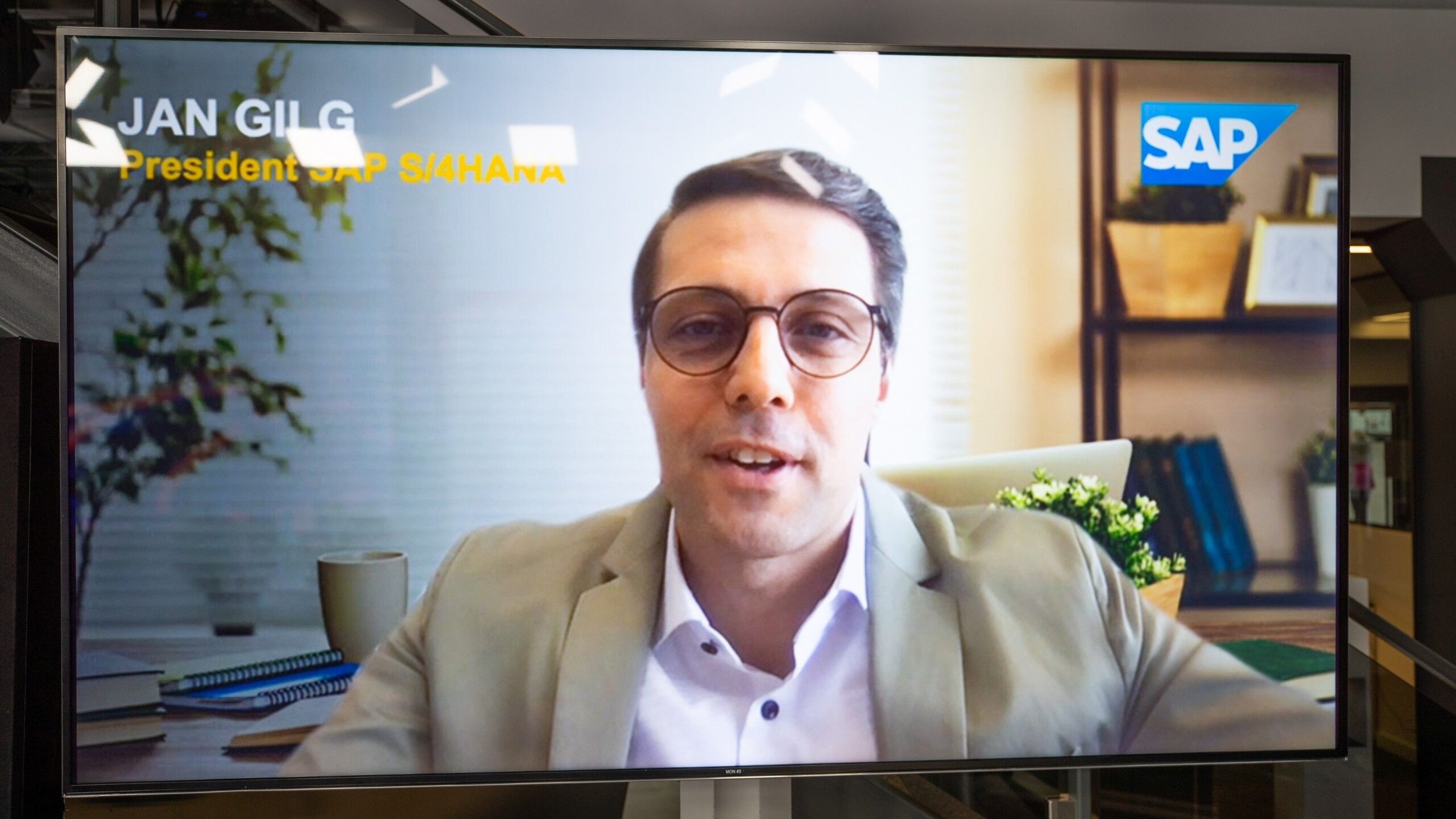Akash Sain – shutterstock.com
SAP has announced its new business strategy with Business Unleashed. In order to support customers in their current business challenges, the German software manufacturer is focusing on three core elements: processes, data and AI. Jan Gilg, Chief Revenue Officer for the Americas region and responsible for SAP Business Suite, is confident that only SAP is able to create a triad from these elements.
“We support companies in efficiently designing entire process chains,” says Gilg, describing SAP’s approach. This also includes preparing the data generated along these process chains for AI use so that those responsible in the companies can gain better insights from their data.
Processes: Business Suite in the cloud
SAP is reactivating a well-known and, above all, successful product label from the classic on-premises era under the name “Business Suite”. Under this name, SAP combined a bundle of different software functions: SAP ECC (SAP ERP Central Component) at the ERP core, supplemented by SAP CRM (Customer Relationship Management), SAP SRM (Supplier Relationship Management), SAP SCM (Supply Chain Management) and SAP PLM (Product Lifecycle Management).
The great advantage that the Business Suite offers from the user’s point of view: All application modules are interlinked and integrated from the outset. Process chains can therefore be completely covered. These capabilities are one of the reasons why the Business Suite is still very popular with many user companies and why many customers invested a lot of money in the application package until a few years ago — even though the successor system, S/4HANA, had been on the market since the beginning of 2015.
SAP now apparently wants to use the good name for its cloud solutions and is probably hoping for more tailwind. This is because many SAP customers are still hesitant about moving their business-critical applications to the cloud. With the new Business Suite, SAP is now in a position to offer end-to-end processes in the cloud as well, says Gilg. To this end, the manufacturer has brought together the various technology stacks and cloud services. The basis for this is the Business Technology Platform (BTP).
The central innovation of the Cloud Business Suite is that entire user process chains can once again be mapped in the newly integrated package, Gilg emphasizes. The SAP manager therefore does not want to talk about a product announcement.
Data: Business Data Cloud (BDC)
The process chains also form the basis for the second note in SAP’s triad — the data. In future, this will be sorted in the Business Data Cloud (BDC). At this point, SAP is talking about a uniform semantic level for data from SAP systems as well as from third-party providers. Michael Ameling, Executive Vice President and Chief Product Officer for BTP, describes the initial situation as follows: “Many companies today have to invest a great deal of effort in maintaining different data sources, harmonizing data landscapes and creating a uniform data layer in the first place. Companies spend up to 50 percent of their IT budget on this.
Ameling compares the BDC to a highly qualified translation machine. After all, the various data sources all speak a different language with the corresponding rules and meanings. The BDC provides user companies with a common semantic level that ensures that all this data can be processed and understood seamlessly together. “Data sources work together harmoniously and provide valuable insights.”
SAP had already promised something similar around two years ago with Datasphere. At the beginning of March 2023, users would be able to use SAP tools and partner tools to access all databases — in SAP and non-SAP systems, in the cloud and on-premises. According to Ameling, the BDC is based on Datasphere. The difference, however, is that the new Data Cloud will be a SaaS offering managed entirely by SAP, whereas Datasphere had to be set up and operated by the customers themselves. The SAP manager reports that this involved an incredible amount of work in some cases.
According to SAP, it integrates the various components of the BDC itself and customers can use the corresponding services out of the box. Ameling cites the integration of Databricks as an example. Their functions are completely embedded in the BDC. “SAP puts everything together and takes care of the management,” says the manager, describing the offering. “One contract, one pricing model.”

IDG
SAP needs to recognize the realities of the market at this point, adds his colleague Gilg. After all, many customers have invested massively in Databricks and have clearly communicated to SAP that they cannot throw out their other data solutions for the BDC, says Gilg, describing the feedback from users. In addition, Databricks brings capabilities in machine learning engineering that SAP cannot offer in the BDC. Databricks and SAP complement each other, says the SAP manager. “SAP with transactional and operational data and unstructured data from Databricks.”
Artificial intelligence: data products and insight apps
Ultimately, the Business Data Cloud managed and controlled by SAP also forms a harmonized data basis that should enable customers to use Business AI for all their data. The software manufacturer announced a series of data products that are located along a wide range of business processes — from finance and supply chain to human resources from SAP SuccessFactors. These data products are based on preconfigured interfaces in the BDC. SAP promises that time-consuming and cost-intensive work relating to data extraction and aggregation will no longer be necessary. The Group is talking about a veritable data product economy that could emerge on the basis of the BDC.
SAP also wants to offer so-called Insights Apps, which are based on a combination of data products and AI models. SAP wants to offer these preconfigured analysis applications for various business areas. For example, there will be a Working Capital Insights app at the start.
Last but not least, SAP is also promising its customers greater efficiency for its own GenAI bot Joule on the basis of the BDC. This will be consistently integrated into all applications, creating more opportunities to build new Joule agents. Ameling promises that users will have ready-made templates and APIs at their disposal. The aim is to create agents that act autonomously with each other in a certain way, along the entire value chain.
SAP is betting everything on the cloud
At this point, Gilg emphasizes that such offers can only be optimized if the corresponding systems at SAP run in the cloud. The manager makes no secret of the fact that SAP is doing everything it can to actively move customers to the cloud. In the past, the software company has not necessarily only made friends with its clientele. In recent years, users have repeatedly criticized functional gaps, a lack of integration and choppy data harmonization in SAP’s cloud solutions.
That is now a thing of the past. “We are now at a stage where we can actually talk about a Business Suite in the cloud again,” asserts Gilg. SAP has always differentiated itself by “not solving individual problems with individual applications or best-of-breed applications, but by looking at business processes end-to-end”. It is precisely these business processes that need to be covered in SAP’s software, and in such a way that the customer ultimately has no integration effort.
The clear message from SAP managers is that this works best when the solution is 100% managed by SAP and runs in the cloud. Many of these integrations also work in the private cloud, but only if customers adapt SAP’s best practices and build extensions in such a way that they comply with SAP’s clean core specifications. However, there is usually still a little project work involved with the private cloud.
On-premises means more project work
According to SAP, however, on-premises customers will have more work to do. They can also connect to cloud products such as Ariba and SuccessFactors. SAP provides corresponding APIs and integrations. “But the whole thing naturally involves a lot more project work,” Gilg clarifies. Customers have a lot of work to do and have to make sure that the corresponding integrations work. “Accordingly, the new SAP Business Suite is also a cloud suite.”
It remains to be seen whether SAP users will follow the path of their software supplier. The German-speaking SAP user group (DSAG) is under no illusions. “SAP has not built any new software,” says Thomas Henzler, DSAG Board Member for Sales, Production & Logistics. “The Business Suite is first and foremost a target image, but not a product.”
SAP is building “managed integration”
In future, customers will buy a Cloud Enterprise Resource Planning (ERP) system, either Cloud Public or Private Edition, explains the user representative. The new Rise and Grow journeys announced as part of this process are intended to guide customers towards this goal. From SAP’s perspective, the strategic ERP product is the S/4HANA Cloud, Public Edition or now Cloud ERP Public.
With regard to integration, the DSAG representative states: “In the past, SAP developed a technical platform with the Cloud Integration Suite and a corresponding mapping. However, customers had to implement, pay for and operate this themselves.” In future, SAP wants to offer more and more “managed integration”, where the software group also takes over the technical operation. Henzler cites the announcement at Sapphire 2024 regarding the customer relationship management (CRM) solution Sales Cloud, which became part of the Grow-with-SAP bundle, as an example of this. Such a “managed integration” already exists here — albeit in the context of S/4HANA Cloud, Public Edition.

DSAG
“At the core of the Business Suite, however, there is also a commercial incentive for customers to buy more SAP through new discount scales based on the number of SAP products used,” says Henzler. The software group seems to want to make it more attractive for customers. “They should use SAP products — especially in line-of-business (LoB) solutions such as CRM — instead of relying on another provider.”
Read More from This Article: SAP builds new business suite in the cloud
Source: News

